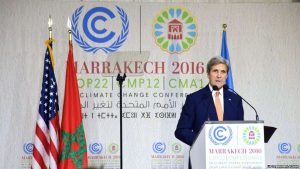I wasn’t sure what to expect this week in Marrakech, particularly coming out of the fog that was the United States election last week. The majority of the side events I’ve attended this week had at least some reference to the election, or the new Trump Administration coming in. However, I’ve found that these discussions have been largely optimistic—something that I found surprising.

U.S. Secretary of State John Kerry delivers a speech at COP22 on November 16. (Photo from: http://www.voanews.com/a/kerry-blasts-climate-change-deniers-at-cop22/3598452.html)
During a meeting with my client, the Climate Registry, I heard from Karen Florini, the Deputy Special Envoy for Climate Change at the U.S. Department of State, who said, “The Paris Agreement will be moving forward with or without the United States. The governing question has now become whether the United States will stay at the table to negotiate.” What’s more, the general sentiment I’ve felt while attending side events and meetings has been that subnational authorities will continue to put their best foot forward, regardless of who occupies the halls of the white house. Indeed, strong subnational action will be needed more in the next four years than ever before. Because of ambitious work by subnational actors, we may be able to reach national carbon targets irrespective of what the national government does.
I attended several talks by Deborah Markowitz, the Secretary of the Vermont Agency of Natural Resources, who spoke to Vermont’s subnational climate action. She also pointed to the 8 years of lack of climate action under the Bush Administration, when Oregon, Washington, and California took the reigns and began to implement determined energy efficiency standards and policies to reduce greenhouse gas emissions, increase energy efficiency standards, and implement more green energy infrastructure.
After attending her talk, among others, I’ve come to believe that it’s truly state government where the rubber meets the road. This is, in part, a result of America’s system of cooperative federalism, where state and local governments interact cooperatively and collectively to address common problems. For environmental regulations, this often means that states are somewhat independent with respect to environmental regulations, and indeed, can implement policies that take Federal standards a step further. Succinctly, my take away from this week has been that states have their own authority and commitments, and are working together to address climate change. Of course, there are limitations to a fragmented, more bottom-up climate regime (how far reaching can a California’s carbon market be, for example, if other states do not join?), but I find a lot of optimism in the state action I’ve learned about this week, particularly in California, Vermont, and Washington.

Presentation: What do Cities, States and Regions Need to Deliver on 1.5 Degrees?
In one of the presentations on subnational actors that I attended, someone posed a question to a panel of subnational climate representatives: “What are some of the tactics you’ve been using to encourage other states that are more hesitant to act to join the fight against climate change?” I thought this was an excellent question—one that is central to the subnational fight against climate change. It seems that one of the primary limitations to subnational action is that their work, by virtue of the fact that its on a much smaller scale, cannot be as extensive. So how do we get other states to join? The responses that the panelists gave all seemed to revolve around the economy—that is, that economic prosperity and lowering emissions are not mutually exclusive. California is a great example of this. Not only is it the number one carbon reducing state in the United States, but in it’s fight against greenhouse gasses it’s also improved its economy. I hope that in the coming years, more states will implement their own clean energy and energy efficient policies, if not primarily to reduce greenhouse gas emissions, then to improve their economies.
Last week, I was incredibly worried about the United States’s climate change prospects. While I wouldn’t say I feel completely confident now, coming out of Marrakech I’ve certainly found more hope. States are increasingly coming into the forefront of climate action, and in doing so, several have demonstrated that it is possible and feasible to improve the economy while tackling greenhouse gasses. Of course, strong subnational action should be a complement to, rather than a replacement for, strong national action, but I’m looking for optimism where I can find it.

Leave a Reply